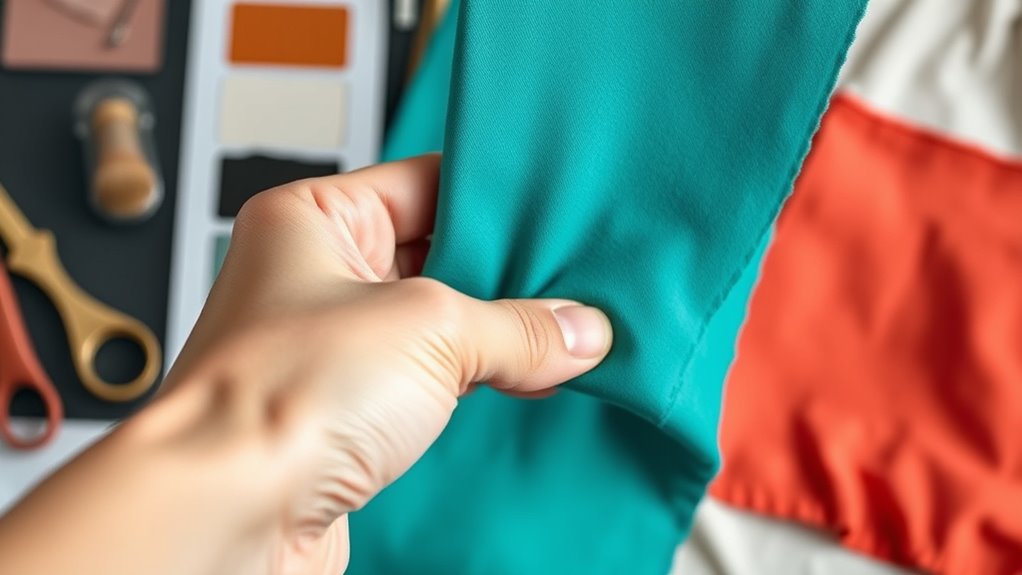To instantly elevate your style, pair complementary colors, like navy and burnt orange, for bold contrast. Use a dominant color and add accessories or shoes in its opposite hue for a quick upgrade. Keep contrasts subtle to avoid clashes and experiment with monochromatic tones for a cohesive look. Knowing the color wheel makes outfit choices faster and more confident. Stay tuned to learn even smarter tricks that stylists rely on for eye-catching outfits.
Key Takeaways
- Pair a dominant color with its complementary hue for instant eye-catching contrast.
- Use accessories or shoes in the complementary color to quickly elevate any outfit.
- Keep contrasting colors subtle to prevent visual clashing and maintain balance.
- Stick to color schemes like analogous or monochromatic for harmonious, effortless styling.
- Choose a single dominant color and add small accents in its complement for a quick, stylish upgrade.

Matching colors can seem tricky, but with a few simple tricks, you can effortlessly create stylish and cohesive outfits. One of the most effective tools in your arsenal is the color wheel. This circular diagram organizes hues in a way that makes understanding color relationships much easier. When you look at the color wheel, you’ll notice that opposite colors—like blue and orange or red and green—are called complementary colors. Pairing these creates a striking contrast that naturally draws the eye and adds vibrancy to your look. As a general rule, wearing complementary colors together guarantees that your outfit will stand out without looking chaotic, especially if you keep the shades balanced. For example, a navy blazer with a burnt orange shirt creates a sharp, eye-catching contrast that’s perfect for both casual and formal settings.
Complementary colors like blue and orange create striking, balanced outfits that stand out effortlessly.
The key is knowing how to use the color wheel to your advantage. When you choose a dominant color for your outfit, look for its complement and consider incorporating it as an accent. If you’re wearing a green dress, adding accessories or shoes in red can elevate your look instantly. The trick is to keep it subtle enough so the colors don’t clash. You might opt for a red belt or lipstick to complement a green ensemble. This approach makes your outfit look intentional and well-thought-out, rather than random.
Additionally, understanding color harmony principles can help you create visually pleasing outfits more intuitively. Another effective trick is to stick with color schemes based on the color wheel, like analogous colors—those that sit next to each other. Pairing shades like yellow and orange or blue and purple creates harmonious outfits that feel naturally coordinated. These combinations are less jarring than contrasting colors and work well when you want a more subdued, sophisticated look. You can also experiment with monochromatic schemes by choosing different shades and tints of a single color, which adds depth without complicating your outfit.
Ultimately, understanding the color wheel and its relationships helps you make smarter choices quickly. Instead of second-guessing whether two colors work together, you’ll have a reliable reference that guides your selections. Complementary colors, in particular, are a quick way to add impact and balance to your wardrobe. With these simple tricks, matching colors becomes less intimidating and more fun, giving you the confidence to put together eye-catching, unified outfits every time you get dressed.
Frequently Asked Questions
How Can I Match Colors Without Professional Tools?
To match colors without professional tools, start by using the color wheel. Find complementary colors, which are opposite each other on the wheel, to create eye-catching contrasts. You can also pair analogous colors, which sit next to each other, for harmony. Trust your eye, compare shades side-by-side, and don’t be afraid to experiment. This simple approach helps you achieve balanced, stylish color matches effortlessly.
What Are Quick Tips for Matching Patterns and Textures?
Think of pattern mixing and color blocking as a dance of contrasts. To match patterns and textures quickly, start with a neutral base and add one bold pattern, then balance it with subtle textures. Keep the color palette cohesive by choosing shades that complement each other. Trust your eye—if it feels right, it probably is. Play with scale and contrast, and you’ll effortlessly create stylish, harmonious outfits.
How Do I Adjust Color Matching for Different Skin Tones?
When adjusting color matching for different skin tone variations, consider your undertones—warm, cool, or neutral. You’ll want to choose makeup shades that complement your skin tone to enhance your natural beauty. For example, warm skin tones go well with earthy hues, while cool tones shine with jewel tones. Always test colors in natural light and coordinate your makeup with your outfit to create a harmonious look.
Are There Specific Color-Matching Tricks for Formal Versus Casual Wear?
Imagine you’re dressing for a fancy wedding versus a casual brunch. For formal wear, you might opt for seasonal pairings like deep emeralds or classic navy, with elegant accessories to elevate the look. Casual outfits lean toward playful color combos and relaxed accessory coordination, like bright scarves or statement jewelry. Adjust your color-matching tricks based on the occasion, emphasizing sophistication for formal events and fun for casual outings.
How Can I Fix Color Mismatches in an Outfit Quickly?
When your outfit’s colors clash, grab your color wheel. Look for complementary colors—those opposite each other—and add a small accessory or layer in one to balance the look. If a top and bottom don’t match, try swapping out accessories or shoes in a complementary hue. This quick fix pulls your outfit together, making mismatched colors harmonize effortlessly and instantly boosting your style confidence.
Conclusion
So, next time you’re unsure about pairing your colors, remember these quick tricks stylists swear by. With just a little practice, you can effortlessly create stunning looks that turn heads. Don’t be afraid to experiment and trust your instincts; sometimes, a subtle hint of a matching shade can make all the difference. Embrace these tips, and you’ll find your style becoming more polished—perhaps even more enchanting—than you ever imagined.









